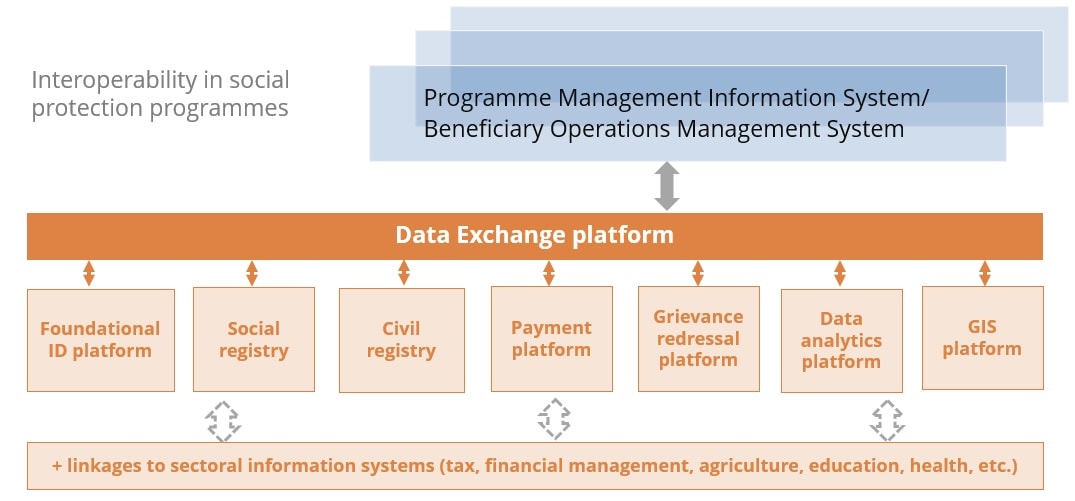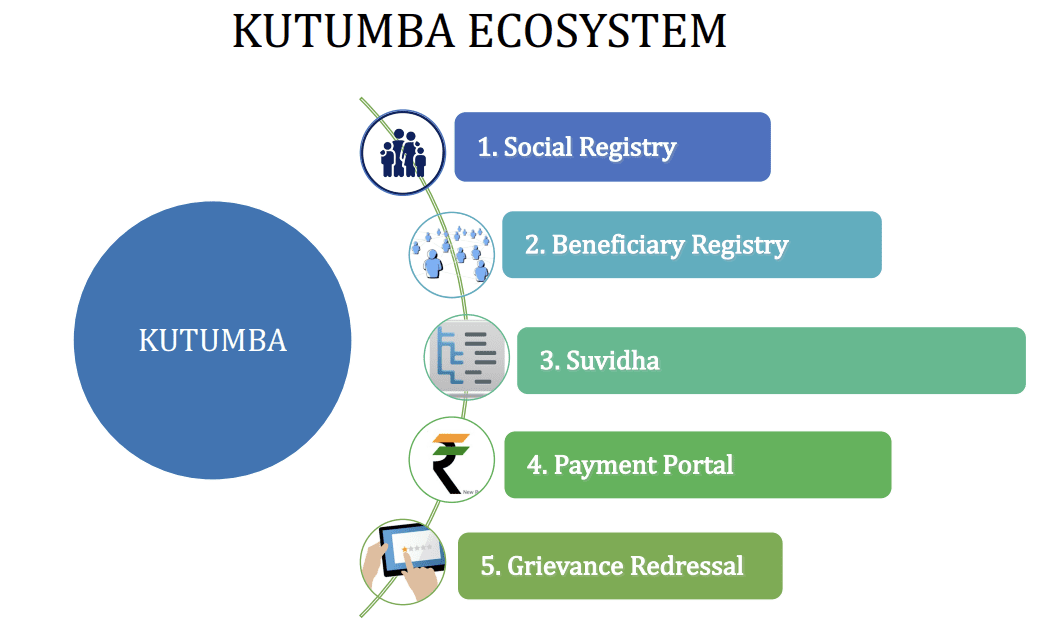The Digital Convergence Initiative is championing common technical standards to make data sharing between social protection institutions, systems and programmes easier, cheaper and more effective
The Covid-19 pandemic – now in its third year – and increasingly frequent climate-related shocks have drawn unprecedented attention to the need for universal social protection; target 1.3 of the Sustainable Development Goals (SDGs). However, despite an upsurge in social assistance schemes, many countries still struggle to provide adequate protection for their citizens; more than half of the world’s population lacks access to basic social protection support, leaving them vulnerable to future crises.
Necessarily broad in scope, social protection systems address the needs of different groups of people at different times in their lives, spanning programmes financed and managed by multiple government and non-government agencies. Social protection programmes consequently need to be agile and dynamic, and above all they must be able to exchange information, and be linked with other government data systems. An important part of the solution lies in developing internationally agreed technical standards to guide the development of digitally integrated and interoperable programmes. This is what digital convergence is all about.
The challenge: promoting interoperability among systems involved in programme delivery
Governments have been harnessing the power of digital technologies for many years to provide social protection services to their most vulnerable citizens. However, particularly during crises, new social protection programmes continue to be created from scratch to provide rapid solutions to specific problems. Not only does this endlessly – and inefficiently – reinvent the wheel, it results in social protection programmes that are fragmented and uncoordinated, posing an additional constraint for efforts to promote interoperability.
A lack of interoperability limits the ability to optimise costs and achieve economies of scale through data sharing, and results in missed opportunities for innovation. As the diagram illustrates, interoperability in social protection programming is needed at two key levels: firstly, between social protection programme systems and registries; and secondly, between social protection and other sectoral programmes, databases and registries, such as tax registries, or health and education programmes. These linkages support decision-making around eligibility and speed up payments to beneficiaries.

These issues are not new – countries have been grappling with them for years, using policy and legislative change to encourage and facilitate the establishment of digital eco-systems in which information can be more efficiently exchanged. However, implementation in the social protection sector has proved challenging, and the essential information needed to administer social protection schemes remains largely stored in separately maintained registries and databases which do not communicate with one another.
Digital social protection needs its own language, syntax and grammar
Social protection lags behind other sectors, such as health, where internationally agreed coding systems for diseases, medical services and procedures support interoperability. For example, the Fast Healthcare Interoperability Resources (FHIR) standard defines how healthcare information can be exchanged between different computer systems regardless of how it is stored in those systems, and initiatives such as Integrating the Healthcare Enterprise (IHE) provide specifications, tools and services for interoperability and promote the coordinated use of established standards.
Rodrigo Ortiz D’avila Assumpcao, Social Protection Management Information Systems Specialist at International Labour Organisation (ILO), said, ‘like health, what we really need in social protection is a common language – with its own grammar and syntax – which will enable the different social protection stakeholders, programmes and processes to interact and understand each other better’.
The Digital Convergence Initiative for Social Protection responds to country needs
This is where the Digital Convergence Initiative for Social Protection comes in. Responding to a groundswell of opinion from countries struggling with these challenges in their social protection sectors, the Initiative was set up in 2021 under the auspices of USP2030. It is a collaborative initiative bringing together governments, development partners, civil society and the private sector to respond to the growing needs at country level for more harmonised standards and terminologies for using digital technologies to implement social protection programmes. The Initiative is jointly steered by Deutsche Gesellschaft für Internationale Zusammenarbeit (GIZ), the ILO and the World Bank.
Creating an ecosystem for ICT innovation
The Initiative’s vision is rightly ambitious, aiming to foster the creation of an ecosystem for innovation among ICT providers to build products that are interoperable, easy to use, and that can be both maintained and scaled, based on globally agreed standards and guidelines. The development of a global consensus around the terms, core elements and standards for digital social protection programmes underpins these ambitions. The Initiative will support the wide promotion and dissemination of the standards, as well as the creation of a managed standards repository to ensure their timely up-dating. In the longer-term, the Initiative plans to establish an independent standardisation and accreditation structure.
As the cartoon nicely illustrates, the work of the Digital Convergence Initiative is not about building new systems to compete with the old, but about consensus building and harmonization of standards at multiple levels, involving both social protection programme implementers and ICT experts. The aim is to strengthen a country’s existing systems and enable them to interact and exchange information with the aim of reaching more people with social protection services.

Sharing good practices and building a community of practice
Right now, the Initiative is focusing on two broad areas of work. Firstly, the analysis and sharing of case studies which provide examples of good practice in achieving interoperability in social protection programming. The Initiative’s kick-off meeting in September 2020 presented case studies of convergence in digital social protection systems from Indonesia and Peru, and an online ‘Talking Interoperability’ dialogue series is currently underway. The first in the series showcased the Kutumba Integrated Social Information System in Karnataka, India.
Secondly, the Initiative is bringing together open source service providers and programmers building the software systems used in social protection programming, that is, developing software applications that deal with verifying identity, assessing eligibility, making payments, and managing information. As Anita Mittal, Senior Advisor at GIZ and Lead of the Digital Convergence Initiative says, ‘it is important to get a community of practice going with members who work first hand on developing the IT solutions, testing different options, seeing what is feasible’.
The aim is to reduce the time and costs of developing solutions at the country and programme level, promoting a modular ‘mix and match’ approach that enables countries to build their own solutions based on the best-available technology. Ralf Rademacher, Head of Programme (Social Protection) at GIZ, likens this approach to building with Lego; once the required pieces have been designed and developed according to internationally agreed technical standards, they can be put together in different ways and tailored to different contexts. This also opens the door to greater innovation.
A good practice example: Karnataka’s Kutumba (= family) Programme
Karnataka is India’s sixth largest state with nearly 70 million inhabitants. It has more than 1,800 different welfare schemes managed across 41 state departments, with large social protection programmes which support farmers and subsidise food, provide social welfare, finance student scholarships and provide health insurance, among many other benefits.
Karnataka’s Kutumba programme – Kutumba meaning family in both Kannada and Hindi – is an Entitlement Management System which is being developed into an Integrated Social Information System (SIIS). The Kutumba ecosystem combines five core components, which together facilitate access by poor and vulnerable people to state welfare benefits. These include the Social Registry, which houses the data of 15 million families representing nearly 80 percent of Karnataka’s population on income, housing, caste and other family characteristics, as well as a beneficiary registry and the Suvidha online eligibility screening and application portal. Then there are interfaces with two state-wide platforms – the State Direct Benefit Transfer platform for payments, and the Integrated Public Grievance Redressal System where people can make complaints against Kutumba.

Based on the philosophy of ‘ask only once’, Kutumba provides a common portal for both online registration and eligibility checks. Citizens can go online using a smart phone or computer and check their and their family’s eligibility for multiple programmes at a single site, considerably reducing their administrative burden. They only need to submit their data once in order to apply for and benefit from multiple schemes, based on a unique Kutumba ID.
Important results have flowed from its introduction, including better evidence-based planning and targeting of those most in need, faster processing of applications and service delivery, and the removal from the system of large numbers of ineligible and deceased beneficiary records, freeing up funds to extend protection to more people. Interoperability between the different programmes has even enabled a ‘push’ system whereby some citizens receive support without having to apply at all, such as compensating farmers for crop losses based on crop survey data, and student scholarships and social pensions for poor families.
How far away are we from achieving universally agreed technical standards for digitalising social protection?
When asked this question, experts from GIZ and ILO agreed that this is a journey that will continue. The development of technical and digital standards necessary for strengthening interoperability in the health sector is showing the way for social protection. And important progress is already being made in developing more integrated and sustainable social protection systems, as demonstrated by the good practice examples in India, Indonesia and Peru. The Digital Convergence Initiative is proving itself to be an effective catalyst, bringing together key stakeholders and enabling learning and digital development that will underpin future progress. Team leader, Anita Mittal sums up the benefits of increased convergence of digital social protection programmes, saying, ‘interoperability of social protection systems will really help to extend coverage of social protection programmes to the poor and needy with minimal barriers. And for interoperability one needs agreed technical standards.’
Corinne Grainger, May 2022

